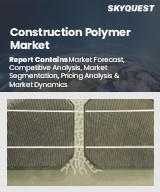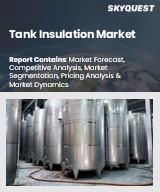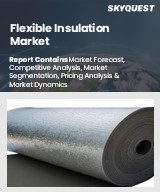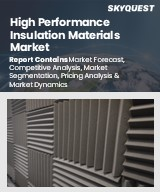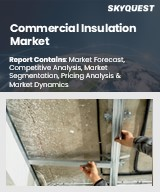
|
시장보고서
상품코드
1787945
세계의 단열재 시장 예측 : 유형별, 용도별, 최종 사용자별, 지역별 분석(-2032년)Insulation Materials Market Forecasts to 2032 - Global Analysis By Type (Polyurethane Spray Foam, Rigid Foam Insulation, Aerogel Insulation and Other Types), Application, End User, and By Geography |
||||||
Stratistics MRC에 따르면 세계의 단열재 시장은 2025년에 783억 달러에 이르고, 예측 기간 중 CAGR은 6.2%를 나타내고, 2032년에는 1,191억 달러에 이를 전망입니다.
단열재는 건물, 차량, 가전제품, 산업 시스템에서 열전도, 소음 및 전기 전도를 줄이는 데 사용되는 물질입니다. 일반적인 유형으로는 유리 섬유, 발포체, 미네랄 울, 셀룰로오스, 에어로겔 등이 있습니다. 이 소재는 에너지 효율을 높이고 실내의 편안함을 유지하며 냉난방 수요를 낮추어 지속가능성에 기여합니다. 그린 빌딩의 기준과 에너지 규제를 충족하는 데 필수적입니다. 환경 친화적이고 내화성이 뛰어난 단열 기술 혁신은 환경 문제에 대한 관심과 건설 수요가 증가함에 따라 시장을 확대하고 있습니다.
다양한 산업 전문가가 수행한 조사에 따르면, 최신 단열 기술은 기존 제품에 비해 에너지 절약을 약 40% 향상시킬 수 있습니다.
세계 건설 및 인프라 지출 증가
단열재 시장은 세계 건설 및 인프라 지출의 지속적인 증가에 의해 크게 견인되고 있습니다. 인구가 증가하고 경제가 발전함에 따라 새로운 주택, 상업용 건물 및 산업용 건물이 끊임없이 필요합니다. 세계 각국의 정부도 도로, 다리, 유틸리티 등의 인프라 프로젝트에 많은 투자를 하고 있습니다. 최신 건축 기준법과 에너지 효율 규제에서는 고성능 절연 재료의 사용이 점차 의무화되고 있습니다. 지속가능하고 환경친화적인 건축 관행의 세계 추진이 이 수요를 더욱 가속화하고 있습니다.
석유화학계 원재료의 불안정성
단열재 시장은 폴리스티렌, 폴리우레탄, 미네랄 울 바인더 등 석유화학계 원재료의 가격 변동으로 인한 큰 억제요인에 직면하고 있습니다. 이러한 원료는 원유가격에 크게 의존하고 있으며, 원유가격은 지정학적 사건이나 수급밸런스의 무너짐에 의해 예측 불가능한 변동을 일으키기 쉽습니다. 이러한 가격 변동은 다양한 단열 제품의 제조 비용에 직접 영향을 미치므로 제조업체가 안정적인 이익률을 유지하기가 어렵습니다. 이러한 화석 연료 파생물에 대한 고유한 의존은 시장에 취약성을 낳고 있습니다.
노후화된 건물의 리노베이션 성장
노후화된 건물이 세계적으로 대량으로 존재하기 때문에 단열재 시장에는 개수의 대처를 통해 큰 기회가 가져옵니다. 많은 오래된 건축물은 최소한의 인슐레이션이나 전혀없는 상태로 건설되어 상당한 에너지 손실을 초래합니다. 에너지 절약에 대한 의식 증가와 광열비 증가는 부동산 소유자에게 단열 보수에 대한 투자를 촉구하고 있습니다. 에너지 효율적인 개축에 대한 정부의 장려금과 보조금은 이 개축 시장을 더욱 자극하고 있습니다. 넷 제로 카본 목표 달성을 목표로 하는 움직임도 대규모 개수가 필요합니다.
대체 에너지 절약 솔루션과의 경쟁
단열재 시장은 대체 에너지 절약 솔루션으로 경쟁이 치열해지는 위협에 직면하고 있습니다. 스마트 서모스탯, 에너지 효율적인 창문, 향상된 HVAC 시스템, 태양전지판과 같은 재생에너지 원과 같은 기술은 자체 에너지 절감에 기여할 수 있습니다. 인슐레이션은 기본이지만 특정 상황에서는 이러한 대안이 우선하거나 충분한 솔루션으로 간주 될 수 있습니다. 이러한 경쟁 솔루션의 지속적인 혁신은 단열 필요성의 긴급성과 규모 인식을 저하시킬 수 있습니다. 이러한 광범위한 에너지 효율의 상황은 경쟁 환경을 창출하고 있습니다.
COVID-19의 영향 :
COVID-19의 대유행에 의해 건설 및 제조 부문 전체에서 공급망의 중단, 노동력 부족, 프로젝트의 지연이 발생해, 단열재 시장은 혼란했습니다. 그러나 이 위기는 또한 에너지 효율적인 리노베이션과 지속 가능한 건축 관행에 대한 관심을 가속화했습니다. 실내 공기의 질과 열적 쾌적성에 대한 의식의 고조가 고성능 절연 수요를 밀어 올렸습니다. 유행 후 경기 회복은 인프라와 그린 빌딩 이니셔티브에 대한 경기 자극 전략에 힘입어 주택, 상업 및 산업용 인슐레이션 용도의 기세를 다시 강화하고 장기 시장 성장에 긍정적인 영향을 미쳤습니다.
폴리우레탄 스프레이 폼 분야는 예측 기간 동안 최대가 될 전망
폴리우레탄 스프레이 폼 분야는 뛰어난 내열성, 기밀성, 경량성으로 예측 기간 동안 최대 시장 점유율을 차지할 것으로 예측됩니다. 주택이나 상업 건축에 널리 채용되어 열손실이나 공기의 침입을 최소한으로 억제함으로써 에너지 절약을 실현합니다. 오픈 셀과 폐쇄 셀의 형태로 다목적이기 때문에 지붕, 벽, 천장 뒷면 등에 적합합니다. 또한 환경 친화적 인 건축자재 및 고성능 단열 시스템에 대한 수요가 증가함에 따라이 분야 시장 우위를 지원합니다.
절연 부문은 예측 기간 동안 가장 높은 CAGR이 예상됩니다.
예측 기간 동안, 절연 분야는 가장 높은 성장률을 나타낼 것으로 예측됩니다. 이는 에너지 효율에 대한 의무화가 증가하고 건물과 산업 시스템에서 온도 조절의 필요성이 증가하는 것이 영향을 미칩니다. 지속 가능한 건축을 추진하는 정부의 규제는 신축 프로젝트와 리노베이션 프로젝트 모두에서 채용을 촉진하고 있습니다. 환경 친화적이고 높은 R 값을 갖춘 절연 기술 혁신은 그 매력을 더욱 향상시키고 있습니다. 세계적으로 에너지 비용이 상승하고 있는 가운데, 주택, 상업, 공업 용도에 있어서 효과적인 차열재에 대한 수요는 계속 가속화되고 있습니다.
최대 점유율을 차지하는 지역
예측 기간 동안 아시아태평양이 가장 큰 시장 점유율을 차지할 것으로 예상되지만, 이는 중국과 인도와 같은 국가에서 급속한 도시화와 산업화가 원동력이 되고 있습니다. 대규모 인프라 개발 프로젝트와 인구의 급증은 주택과 상업용 건물 모두에 엄청난 수요를 낳고 있습니다. 이러한 신흥 경제 국가에서는 에너지 효율에 대한 규제가 점점 엄격 해지고 있으며, 절연 재료의 사용도 의무화되고 있습니다. 이러한 왕성한 건설 활동과 진화하는 규제 상황의 조합으로 아시아태평양은 가장 큰 시장이 되었습니다.
CAGR이 가장 높은 지역 :
예측 기간 동안 북미가 가장 높은 CAGR을 나타낼 것으로 예측됩니다. 이것은 에너지 효율을 고려한 엄격한 건축 기준과 지속 가능한 건설 관행에 대한 강한 주목 때문입니다. 적절한 인슐레이션으로 인한 장기적인 비용 절감과 환경적 이점에 대한 소비자와 건설업자의 의식 증가가 수요를 촉진하고 있습니다. 노후화된 건물의 에너지 개선을 위한 리노베이션에 많은 투자가 이 성장 가속에 기여하고 있습니다. 에너지 효율적인 주택과 건물에 대한 정부 우대 조치와 세액 공제는 북미 시장 확대를 더욱 자극하고 있습니다.
무료 주문을 받아서 만드는 서비스:
이 보고서를 구독하는 고객은 다음 무료 맞춤설정 옵션 중 하나를 사용할 수 있습니다.
- 기업 프로파일
- 추가 시장 기업의 종합적 프로파일링(3개사까지)
- 주요 기업의 SWOT 분석(3개사까지)
- 지역 세분화
- 고객의 관심에 응한 주요국 시장 추정, 예측 및 CAGR(주 : 타당성 확인에 따름)
- 경쟁 벤치마킹
- 제품 포트폴리오, 지리적 존재, 전략적 제휴에 기반한 주요 기업 벤치마킹
목차
제1장 주요 요약
제2장 서문
- 개요
- 이해관계자
- 조사 범위
- 조사 방법
- 데이터 마이닝
- 데이터 분석
- 데이터 검증
- 조사 접근
- 조사 자료
- 1차 조사 자료
- 2차 조사 자료
- 전제조건
제3장 시장 동향 분석
- 성장 촉진요인
- 억제요인
- 기회
- 위협
- 용도 분석
- 최종 사용자 분석
- 신흥 시장
- COVID-19의 영향
제4장 Porter's Five Forces 분석
- 공급기업의 협상력
- 구매자의 협상력
- 대체품의 위협
- 신규 참가업체의 위협
- 경쟁 기업간 경쟁 관계
제5장 세계의 단열재 시장 : 유형별
- 폴리우레탄 스프레이 폼
- 섬유 단열
- 유리 섬유
- 미네랄 울
- 플라스틱 섬유
- 셀룰로오스
- 경질 폼 단열
- 발포 폴리스티렌(EPS)
- 압출 폴리스티렌(XPS)
- 폴리이소시아누레이트(폴리이소, ISO)
- 폴리우레탄(PU)
- 에어로겔 단열
- 기타 유형
제6장 세계의 단열재 시장 : 용도별
- Thermal Insulation
- 방음 단열
- 전기 단열
- 방진 단열
- 내화 단열
제7장 세계의 단열재 시장 : 최종 사용자별
- 인프라
- 건설
- 산업
- HVAC
- 운송
- 가전제품
- OEM
- 기타 최종 사용자
제8장 세계의 단열재 시장 : 지역별
- 북미
- 미국
- 캐나다
- 멕시코
- 유럽
- 독일
- 영국
- 이탈리아
- 프랑스
- 스페인
- 기타 유럽
- 아시아태평양
- 일본
- 중국
- 인도
- 호주
- 뉴질랜드
- 한국
- 기타 아시아태평양
- 남미
- 아르헨티나
- 브라질
- 칠레
- 기타 남미
- 중동 및 아프리카
- 사우디아라비아
- 아랍에미리트(UAE)
- 카타르
- 남아프리카
- 기타 중동 및 아프리카
제9장 주요 발전
- 계약, 파트너십, 협업, 합작투자
- 인수와 합병
- 신제품 발매
- 사업 확대
- 기타 주요 전략
제10장 기업 프로파일링
- 3M
- Atlas Roofing Corp.
- BASF
- Bridgestone Corp.
- Covestro AG
- DuPont
- Kingspan Group
- Knauf Insulation
- Owens Corning
- Recticel NV/SA
- Rockwool International A/S
- GAF Materials Corporation
- Saint-Gobain SA
- Roxul Inc.
- Huntsman International LLC
According to Stratistics MRC, the Global Insulation Materials Market is accounted for $78.3 billion in 2025 and is expected to reach $119.1 billion by 2032 growing at a CAGR of 6.2% during the forecast period. Insulation materials are substances used to reduce heat transfer, noise, or electrical conductivity in buildings, vehicles, appliances, and industrial systems. Common types include fiberglass, foam, mineral wool, cellulose, and aerogels. These materials improve energy efficiency, maintain indoor comfort, and contribute to sustainability by lowering heating and cooling demands. They are essential for meeting green building standards and energy regulations. Innovations in eco-friendly and fire-resistant insulation are expanding the market as environmental concerns and construction demands grow.
According to research performed by various industry professionals, modern insulation technologies can improve energy savings by approximately 40% compared to traditional products.
Market Dynamics:
Driver:
Rise in global construction and infrastructure spending
The insulation materials market is significantly driven by the sustained rise in global construction and infrastructure spending. As populations grow and economies develop, there is a continuous need for new residential, commercial, and industrial buildings. Governments worldwide are also investing heavily in infrastructure projects like roads, bridges, and public utilities. Modern building codes and energy efficiency regulations increasingly mandate the use of high-performance insulation materials. The global push for sustainable and green building practices further accelerates this demand.
Restraint:
Volatility in petrochemical-based raw materials
The insulation materials market faces a significant restraint due to the volatility in prices of petrochemical-based raw materials, such as polystyrene, polyurethane, and mineral wool binders. These materials are heavily dependent on crude oil prices, which are prone to unpredictable fluctuations due to geopolitical events and supply-demand imbalances. Such price volatility directly impacts the production costs of a wide range of insulation products, making it challenging for manufacturers to maintain stable profit margins. This inherent reliance on fossil fuel derivatives creates vulnerability for the market.
Opportunity:
Growth in retrofitting of aging buildings
The substantial global stock of aging buildings presents a significant opportunity for the insulation materials market through retrofitting initiatives. Many older structures were built with minimal or no insulation, leading to considerable energy losses. Growing awareness of energy conservation and increasing utility costs are driving property owners to invest in insulation upgrades. Government incentives and subsidies for energy-efficient renovations further stimulate this retrofitting market. The push for achieving net-zero carbon goals also necessitates extensive retrofitting efforts.
Threat:
Competition from alternative energy-saving solutions
The insulation materials market faces a threat from the growing competition posed by alternative energy-saving solutions. Technologies such as smart thermostats, energy-efficient windows, improved HVAC systems, and renewable energy sources like solar panels can independently contribute to energy reduction. While insulation is fundamental, these alternatives can sometimes be prioritized or seen as sufficient solutions in certain contexts. Continuous innovation in these competing solutions could potentially reduce the perceived urgency or scale of insulation needs. This broader energy efficiency landscape creates a competitive environment.
Covid-19 Impact:
The COVID-19 pandemic disrupted the insulation materials market due to supply chain interruptions, labor shortages, and project delays across the construction and manufacturing sectors. However, the crisis also accelerated interest in energy-efficient retrofitting and sustainable building practices. Increased awareness around indoor air quality and thermal comfort boosted demand for high-performance insulation. Post-pandemic recovery, driven by stimulus spending on infrastructure and green building initiatives, reignited momentum across residential, commercial, and industrial insulation applications, positively influencing long-term market growth.
The polyurethane spray foam segment is expected to be the largest during the forecast period
The polyurethane spray foam segment is expected to account for the largest market share during the forecast period propelled by its superior thermal resistance, air-sealing capability, and lightweight application. Widely adopted in residential and commercial construction, it offers energy savings by minimizing heat loss and air infiltration. Its versatility in both open-cell and closed-cell forms makes it suitable for roofs, walls, and crawlspaces. Additionally, increased demand for green building materials and high-performance insulation systems sustains the segment's dominance in the market.
The thermal insulation segment is expected to have the highest CAGR during the forecast period
Over the forecast period, the thermal insulation segment is predicted to witness the highest growth rate, influenced by rising energy efficiency mandates and the growing need for temperature regulation in buildings and industrial systems. Government regulations promoting sustainable construction are driving adoption across both new and retrofit projects. Innovations in eco-friendly and high R-value insulation materials are further boosting appeal. As energy costs surge globally, demand for effective thermal barriers in residential, commercial, and industrial applications continues to accelerate.
Region with largest share:
During the forecast period, the Asia Pacific region is expected to hold the largest market share, driven by rapid urbanization and industrialization in countries like China and India. Massive infrastructure development projects and a surging population create immense demand for both residential and commercial buildings. Increasingly stringent energy efficiency regulations in these developing economies are also mandating the use of insulation materials. This combination of strong construction activity and evolving regulatory landscape positions Asia Pacific as the largest market.
Region with highest CAGR:
Over the forecast period, the North America region is anticipated to exhibit the highest CAGR, driven by, stringent energy efficiency building codes and a strong focus on sustainable construction practices. The increasing awareness among consumers and builders about the long-term cost savings and environmental benefits of proper insulation fuels demand. Significant investments in retrofitting aging buildings for energy upgrades also contribute to this accelerated growth. Government incentives and tax credits for energy-efficient homes and buildings further stimulate market expansion in North America.
Key players in the market
Some of the key players in Insulation Materials Market include 3M, Atlas Roofing Corp., BASF, Bridgestone Corp., Covestro AG, DuPont, Kingspan Group, Knauf Insulation, Owens Corning, Recticel NV/SA, Rockwool International A/S, GAF Materials Corporation, Saint-Gobain S.A., Roxul Inc., and Huntsman International LLC.
Key Developments:
In June 2025, BASF introduced a bio-based version of its Neopor(R) insulation material, incorporating renewable raw materials to meet rising demand for eco-efficient building insulation in the European market.
In May 2025, Kingspan Group unveiled its new QuadCore(TM) 2.0 insulated panels offering superior fire resistance and thermal conductivity, aimed at commercial infrastructure and cold chain logistics facilities.
In April 2025, Rockwool International A/S announced the expansion of its stone wool insulation production capacity in Eastern Europe to meet growing regional demand driven by stricter building energy codes.
Types Covered:
- Polyurethane Spray Foam
- Rigid Foam Insulation
- Aerogel Insulation
- Other Types
Applications Covered:
- Thermal Insulation
- Acoustic Insulation
- Electrical Insulation
- Vibration Insulation
- Fire-Resistant Insulation
End Users Covered:
- Infrastructure
- Construction
- Industrial
- HVAC
- Transportation
- Appliances
- OEM
- Other End Users
Regions Covered:
- North America
- US
- Canada
- Mexico
- Europe
- Germany
- UK
- Italy
- France
- Spain
- Rest of Europe
- Asia Pacific
- Japan
- China
- India
- Australia
- New Zealand
- South Korea
- Rest of Asia Pacific
- South America
- Argentina
- Brazil
- Chile
- Rest of South America
- Middle East & Africa
- Saudi Arabia
- UAE
- Qatar
- South Africa
- Rest of Middle East & Africa
What our report offers:
- Market share assessments for the regional and country-level segments
- Strategic recommendations for the new entrants
- Covers Market data for the years 2024, 2025, 2026, 2028, and 2032
- Market Trends (Drivers, Constraints, Opportunities, Threats, Challenges, Investment Opportunities, and recommendations)
- Strategic recommendations in key business segments based on the market estimations
- Competitive landscaping mapping the key common trends
- Company profiling with detailed strategies, financials, and recent developments
- Supply chain trends mapping the latest technological advancements
Free Customization Offerings:
All the customers of this report will be entitled to receive one of the following free customization options:
- Company Profiling
- Comprehensive profiling of additional market players (up to 3)
- SWOT Analysis of key players (up to 3)
- Regional Segmentation
- Market estimations, Forecasts and CAGR of any prominent country as per the client's interest (Note: Depends on feasibility check)
- Competitive Benchmarking
- Benchmarking of key players based on product portfolio, geographical presence, and strategic alliances
Table of Contents
1 Executive Summary
2 Preface
- 2.1 Abstract
- 2.2 Stake Holders
- 2.3 Research Scope
- 2.4 Research Methodology
- 2.4.1 Data Mining
- 2.4.2 Data Analysis
- 2.4.3 Data Validation
- 2.4.4 Research Approach
- 2.5 Research Sources
- 2.5.1 Primary Research Sources
- 2.5.2 Secondary Research Sources
- 2.5.3 Assumptions
3 Market Trend Analysis
- 3.1 Introduction
- 3.2 Drivers
- 3.3 Restraints
- 3.4 Opportunities
- 3.5 Threats
- 3.6 Application Analysis
- 3.7 End User Analysis
- 3.8 Emerging Markets
- 3.9 Impact of Covid-19
4 Porters Five Force Analysis
- 4.1 Bargaining power of suppliers
- 4.2 Bargaining power of buyers
- 4.3 Threat of substitutes
- 4.4 Threat of new entrants
- 4.5 Competitive rivalry
5 Global Insulation Materials Market, By Type
- 5.1 Introduction
- 5.2 Polyurethane Spray Foam
- 5.2.1 Fibrous Insulation
- 5.2.2 Fiberglass
- 5.2.3 Mineral Wool
- 5.2.4 Plastic Fibers
- 5.2.5 Cellulose
- 5.3 Rigid Foam Insulation
- 5.3.1 Expanded polystyrene (EPS)
- 5.3.2 Extruded polystyrene (XPS)
- 5.3.3 Polyisocyanurate (Polyiso, ISO)
- 5.3.4 Polyurethane (PU)
- 5.4 Aerogel Insulation
- 5.5 Other Types
6 Global Insulation Materials Market, By Application
- 6.1 Introduction
- 6.2 Thermal Insulation
- 6.3 Acoustic Insulation
- 6.4 Electrical Insulation
- 6.5 Vibration Insulation
- 6.6 Fire-Resistant Insulation
7 Global Insulation Materials Market, By End User
- 7.1 Introduction
- 7.2 Infrastructure
- 7.3 Construction
- 7.4 Industrial
- 7.5 HVAC
- 7.6 Transportation
- 7.7 Appliances
- 7.8 OEM
- 7.9 Other End Users
8 Global Insulation Materials Market, By Geography
- 8.1 Introduction
- 8.2 North America
- 8.2.1 US
- 8.2.2 Canada
- 8.2.3 Mexico
- 8.3 Europe
- 8.3.1 Germany
- 8.3.2 UK
- 8.3.3 Italy
- 8.3.4 France
- 8.3.5 Spain
- 8.3.6 Rest of Europe
- 8.4 Asia Pacific
- 8.4.1 Japan
- 8.4.2 China
- 8.4.3 India
- 8.4.4 Australia
- 8.4.5 New Zealand
- 8.4.6 South Korea
- 8.4.7 Rest of Asia Pacific
- 8.5 South America
- 8.5.1 Argentina
- 8.5.2 Brazil
- 8.5.3 Chile
- 8.5.4 Rest of South America
- 8.6 Middle East & Africa
- 8.6.1 Saudi Arabia
- 8.6.2 UAE
- 8.6.3 Qatar
- 8.6.4 South Africa
- 8.6.5 Rest of Middle East & Africa
9 Key Developments
- 9.1 Agreements, Partnerships, Collaborations and Joint Ventures
- 9.2 Acquisitions & Mergers
- 9.3 New Product Launch
- 9.4 Expansions
- 9.5 Other Key Strategies
10 Company Profiling
- 10.1 3M
- 10.2 Atlas Roofing Corp.
- 10.3 BASF
- 10.4 Bridgestone Corp.
- 10.5 Covestro AG
- 10.6 DuPont
- 10.7 Kingspan Group
- 10.8 Knauf Insulation
- 10.9 Owens Corning
- 10.10 Recticel NV/SA
- 10.11 Rockwool International A/S
- 10.12 GAF Materials Corporation
- 10.13 Saint-Gobain S.A.
- 10.14 Roxul Inc.
- 10.15 Huntsman International LLC






